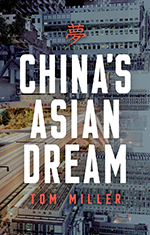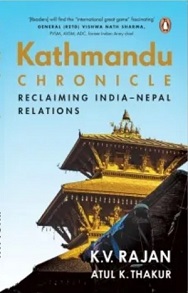The One Belt One Road Initiative or the Belt and Road Initiative (BRI) is one of the most widely discussed topics in the Chinese Foreign Policy. It has been five years since the launch of the BRI. On 17 May 2013 and 7 September 2013, Xi Jinping delivered speeches in Indonesia and Kazakhstan respectively highlighting the importance of connectivity vis-a-vis these countries with China. Against this background, Tom Miller’s book on the BRI is an opportunity to analyse the developments of the initiative. The twin objective of the BRI is to improve connectivity of the lesser developed region of China with the mainland and to increase China’s influence in its neighbourhood.
The BRI is Xi Jinping’s signature project, designed to carry forward his legacies. Miller explicates that under the policy, China is not trying to challenge the existing global architecture, but rather it is trying to reshape it. Although Xi Jinping calls it a ‘Chinese Dream’ it does not really mean that China seeks to supplant the US as the superpower. Conversely, it means that China is looking for a dominant position in Asia, to begin with. Thus under the umbrella of BRI, China is pursuing an assertive foreign policy that gives emphasis to China’s economic leadership in Asia. Simultaneously, China is trying to seek a “new type of great power relationship” with the US, demanding that China should be treated at par with the US. Recently, amid the US-China trade war, this notion seems to be fading away.
Miller expounds that for China to become a regional power it needs to increase its investments in the region and be observant that there is no backlash against China. He has elucidated his experience while travelling to many of the BRI countries. Based on his travelogue, Miller has explicated the changes in the Xinjiang after the launch of the BRI.
As China is carrying infrastructural development in its western periphery, it will also increase its presence in the Central Asian Region as well. Energy imports from Central Asia accounts for one per cent of Chinese trade, but its geostrategic value is substantially much more. Inadvertently, it might affect the China-Russia relation vis-a-vis the Region. Miller further cautions China that the Chinese firms are becoming unpopular in the Central Asian Region. Hence they should be aware of any blow-back that would, in turn, affect their western development strategy.
In the Southeast Asian region, China has made an extensive investment in Cambodia, Myanmar and Vietnam. Cambodia has endorsed the BRI. As a precaution, the investments coming in should be used judiciously. For China getting too close to Cambodia may drive it away from other countries like Vietnam. In Myanmar, China has been the only country to provide support for the last two decades. But with the transition to democracy, Myanmar is trying to move away from China. At present, there are many countries interested in Myanmar and it has also become a space for China-US competition. Miller argues that for China to realise its ‘Asian dream’, it has to live up to its promises of delivering mutually beneficial development.
In the Indian Ocean Region, Sri Lanka is the ‘test case’ for China, as to how its leaders and enterprises can respond to the changes in other countries. Similarly, in the South China Sea region, Vietnam is the ‘acid test’ for China’s Asian diplomacy. Further, Miller argues that the Chinese assertion in the South China and the East China Sea’s is about self-protection and national glory. This, in turn, is at the core of the ‘Chinese Dream’.
Miller further expounds on the changes that have taken place in the Chinese foreign policy with the launch or the BRI. Prior to the launch of the initiative, one of the basic tenants of the foreign policy was ‘non-interference’ and ‘non-alignment’. Since the last five years, China is trying to build a “community of shared destiny” in Asia which essentially runs contradictory to the principle of non-interference. The old tenets of Chinese foreign policy began to unravel after the leadership transition in 2012-2013. In 2013, Xi Jinping made a speech titled “Let the Sense of Community of Common Destiny Take deep Root in Neighbouring Countries.” This is in sharp contradiction to Deng Xiaoping’s taoguang yanghui (keeping low profile). Xi Jinping’s is propagating fenfa youwei (striving for achievements).
Miller argues that the strategic goal of the BRI is to promote China as an engine of development, weaving a web of inter-dependence across Asia and beyond. China hopes that the incentive of massive infrastructure investment will persuade Asian countries to put their economic interests above security concerns. China will deliver trade investment and other economic perks to all partners that accommodate China’s core interest.
Miller goes on to state that China’s has made a lot of investments in its neighbourhood. There has been looming suspicion about the completion of these investments. If they don’t fructify, China will lose the trust of its neighbours. China’s neighbour will avoid a situation where they are sandwiched between the US and China. In its endevour therefore, China is trying to decrease American influence in its neighbourhood. This was clearly stated at the fourth Conference on Interaction and Conference Building Measures in Asia (CICA) Summit held in Shanghai. During the conference, Xi Jinping unveiled a new ‘Asian Security Concept’. He also mentions that the role of the US in Asia should decrease. On the contrary, the problem for China is that not many Asian countries want the US to leave the region. Miller argues that the US strategy towards China is “engagements and not containment”. Nevertheless, the US continues to regard China as a strategic rival to be kept in place. Miller recommends that the US should be more accommodative towards China, “the safest course of action is to accommodate it within a remodeled regional security structure”.
Overall, it is an interesting analysis of China’s regional strategy, with perspective from each country that is detailed in various chapters. Miller has done extensive field survey in almost all the countries mentioned in the book. However, he has skipped the issue of overcapacity vis-à-vis the BRI and as to how each of these countries can help China in solving this issue. Nevertheless, it is one of the elementary reading for anyone who is trying to understand Chinese Foreign Policy.










Post new comment